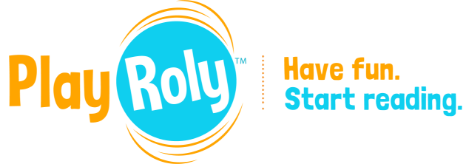
Science of reading and Play Roly
Science of reading, Play Roly, early literacy, and the development of reading skills
Play Roly teaches children, at the optimal age of 3 to 5 years, the essential first steps to read. About 25% of children fail to grasp these critical skills in early elementary classroom settings. A free, at-home, one-on-one playful learning activity that’s easy to use, Play Roly is founded on decades of science of reading research. Play Roly is used to ensure kids develop vital skills for reading that, when neglected, become a common learning barrier.
The science of reading, often referred to as SOR, is a broad term relating to reading research findings regarding how we learn to read. Play Roly has been developed based on essential teaching skills from the science of reading early literacy findings. Science shows us that the optimal age for effective early intervention in reading difficulty is ages 4 to 6. Play Roly embeds reading-intervention techniques, teaching all children as if they are at-risk of difficulty, in an age-appropriate way between the ages of 3 and 5. While, on the surface, Play Roly is a fun game for children, the game utilizes decades of research in the areas of education, neuroscience, and reading development in children.
What is a phoneme and how does it relate to early reading?
A phoneme is a spoken letter sound. In Play Roly, Roly speaks in phonemes. For example, the phoneme “mmm”, represented in print by the letter m, is one of three phonemes heard when saying the word “mat”. The other two are “ah” and “t”.
Learning “Roly’s language of phonemes or letter-sounds” may feel to kids like learning the spoken language of reading, because Roly’s phonemes correspond with printed letters in kids’ homemade Roly-word book. However, a phoneme is verbal—it refers to the tiny speech fragment that relates to the letter sound, not the letter itself.
Why are phonemes and phonemic awareness (PA) studied in the science of reading?
Phonemes allow readers to make the connection between speech and print. And Play Roly helps kids develop an awareness of these tiny verbal fragments of speech, called phonemes, by exaggerating Roly’s phonemes (holding the sound for over a second) and repeating them a minimum of six times. Roly pronounces the three phonemes in the Roly-word without breaks between so they sound more like speech (continuant blending), and lastly, draws the child’s attention to the meaning of the blended phonemes by asking him/her what Roly is saying.
“When children discover a critical fact, that letters correspond to sounds that make up spoken words, their approach to both reading and spelling shifts”.
—Dr. Louisa Cook Moats from her book Speech to Print: Language Essentials for Teachers (2020)
Phoneme fluency
When kids can both discern and engage in play with the letter sounds in speech, they are fluent in Roly’s language. This means they can verbally segment Roly’s words into phonemes (e.g., in Play Roly 3). In the future, when kids learn to read, they will memorize 44 phonemes that correspond to hundreds of combinations of letters. Sometimes one phoneme such as ‘fff’ matches to a single letter like ‘f’ in fun; or to multiple letters like ‘ph’ in the word phone.
What is phonological awareness and when does it start to develop?
Phonemic awareness (described above) is the most advanced kind of phonological awareness—a broad term that relates to many different ways of being able to separate from the meaning of speech in order to discern its sounds. When children can hear which two words rhyme, they are using this skill.
Phonological awareness skills start to develop around age 3. You might see a 4-year-old with strong phonological awareness playing with rhymes or words that all start with the same first sound, e.g., repeating “Peter Piper picked a peck of pickled peppers”.

Why is there so much research on phonological and phonemic awareness?
Phonological and phonemic awareness (PA) are important skills that have been studied for decades because they are critical to success in reading and writing. There are vast numbers of studies of PA in the fields of education, childhood development, learning disabilities, neuroscience, psychology, speech pathology, and medicine. Ideally, kids between the ages of three to five should engage in play with the sounds of words and develop phonological and then phonemic awareness.
“Phonological awareness training can really help all children become better readers”.
—Dr. Linda Siegel, author of “Not Lazy, Not Stupid, Understanding Dyslexia.”
What other early literacy skills are important?
In addition to phonemic awareness—verbal blending and segmenting—the following skills are also often studied in reading research and encouraged in early literacy:
- Early writing—when kids can print their name and some letters
- Letter naming—when kids can name the upper and lower case letters of the alphabet
- Letter sounds—when kids learn some early letter-sound correspondences
- Alphabetic principle—when kids can understand that printed letters have sounds that we blend into words to read
Play Roly’s free video lessons encourage all of these skills. As long as you and your young child enjoy playing, you can return to them as often as you like.
Play Roly prevents the root cause of many reading difficulties
What Play Roly Teaches
Strengthens phonological awareness—an essential reading skill
When
Between the ages of 3 and 5
How
Through simple, fun, progressive building block techniques that are effective for all children
Why
To delight, inspire confidence, and introduce the joy of reading to every young learner
Timeframe
Two-minute videos played daily—most kids start to learn Roly’s language within a week (i.e., in less than 15 minutes total time practicing and having fun)
The impacts of Play Roly
- Applies the two proven research principles—it strengthens phonological awareness, early and teaches children age-appropriately the foundations of reading
- Helps all children because all kids require phonological awareness to learn to read
- Has the biggest positive impact on the many vulnerable children for whom phonological awareness would not otherwise strengthen age-appropriately
- Ensures all children have the opportunity to achieve their goals, develop their full potential, and participate in society
How does Play Roly teach through play?
Play Roly is a phonological awareness game that engages kids in play, which is an effective way for all children to learn. It is designed so that even a child who is born with extremely weak phonological awareness can learn through the activity.
HELPS CHILDREN DISCOVER LETTER SOUNDS WITHIN WORDS
Play Roly helps through slow, exaggerated, repetitive, physical, musical, rhythmic, fun — and children both hear and say the sounds. When children draw the ‘meaning’ of Roly’s words, they are making neural connections between where they store speech’s meaning and where they learn to process letter sounds.
HELPS CHILDREN TRANSITION TO THE SKILL OF BLENDING SOUNDS—AN IMPORTANT SKILL FOR READING
Play Roly uses letter sounds that can be held without pauses in between so that three spoken letter sounds sound like one long slow word (‘mmmmaaaaannn’) rather than three separate words (‘muh-ah-nuh’). Verbally blending letter sounds can be hard but the game makes it easier by framing it as speaking Roly’s language very slowly.
PREVENTS THE LOSS OF SELF-ESTEEM IN CHILDREN WHO NEED MORE TIME
Play Roly helps all children learn the new language of letter sounds at ages 3 to 5 when the brain is highly receptive to learning new languages. The activity allows each child to learn letter sounds without comparison to other children, one-on-one with an interacting adult, in a familiar and quiet environment at home, and at their own pace.
When learning takes longer—look for the gifts
Neuro pathways associated with innovative thinking cannot be taught. Reading can. Children who take longer to learn to speak Roly’s language of letter sounds may be developing neural pathways needed to read from scratch. So it takes longer. Their neural pathways in other areas of the brain may be exceptionally well developed. This may make them highly visual or enjoy exceptional creativity, imagination or intuition. These children may be our planet’s future innovators, creatives, entrepreneurs, or intuitives. We want them to thrive—not just survive—in reading and in life.


